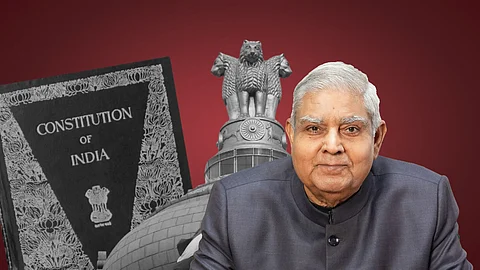

IN A SURPRISING TURN OF EVENTS, the Vice President of India, Jagdeep Dhankhar, tendered his resignation on July 21, 2025, citing “health reasons” creating a rare mid-term vacancy in the constitutional office. The Constitution of India, 1950 (“Constitution”) provides clear guidelines for presidential vacancies. However, the provisions for the vice presidency are notably vague and not time bound.
The Constitutional framework for vacancies
The Constitution outlines the structures of key offices to ensure continuity and stability in governance. Article 63 establishes the office of the Vice President, who also serves as the ex-officio Chairman of the Rajya Sabha. When it comes to vacancies, the Constitution draws a stark contrast between the presidency and the vice presidency, at Articles 62 and 68 respectively.
The Constitution mandates that an election to fill a vacancy in the office of the President, arising from death, resignation, removal, or otherwise, must be held “as soon as possible after the occurrence, but in no case later than six months” from the date of the vacancy. This upper limit ensures that the nation is not left without the head of state for an extended period.
In contrast, for the Vice President, no such upper limit exists. It states that an election to fill a vacancy caused by death, resignation, removal, or otherwise shall be held as soon as possible after the occurrence of such an event. Absent is any maximum timeframe, leaving the phrase “as soon as possible” open to interpretation and open to strategy manoeuvres.
Historical context and the unprecedented nature
India has rarely seen a mid-term vacancy in the Vice Presidency. Jagdeep Dhankhar’s 2025 resignation is only the third such case. The earlier instances were Vice Presidents V.V. Giri (1969) and R. Venkataraman (1987), both of whom resigned mid-term to run for Presidency. In both the cases, successors, Gopal S. Pathak in 1969 and Shankar Dayal Sharma in 1987, were elected soon afterward. By comparison, Vice President Bhairon Singh Shekhawat’s 2007 resignation to contest the Presidency left the post vacant for only 21 days before Mohammad Hamid Ansari was elected. Outside these examples, no sitting Vice President had quit mid-tenure until now.
Vice-President Dhankhar tendered his resignation on the first day of the Monsoon Session citing health reasons. He had taken office in August 2022 for a term running until 2027. This sudden mid-term exit is unprecedented apart from those planning to run for President and it has highlighted a rare constitutional gap.
Immediate aftermath and interim arrangements
With the Vice Presidential post now vacant, Rajya Sabha proceedings continue under the Deputy Chairman. As noted, Article 91 of the Constitution requires the Deputy Chairman to act as Chairman of the Council of States when the Vice President is absent. Accordingly, Harivansh Narayan Singh has assumed the role of acting Chairman and is presiding over the ongoing Monsoon Session.
The timeline for re-electing a new Vice President remains in the abyss as the mandate to be followed is “as soon as possible.” What constitutes “as soon as possible”? Is it days, weeks, or months? In this vagueness, it might allow the government to delay the re-election, potentially for political convenience, thereby affecting the functioning of the Rajya Sabha and the overall balance of power.
The phrase “as soon as possible” vests implicit discretion in the executive to initiate the electoral process. Without an upper limit, similar to the six month cap for the presidency, there is no provision to compel the executive for timely action. This ambiguity has the potential to undermine the spirit of Article 68. As India navigates this unprecedented situation, the current vacancy demands not just an election but a broader reflection on strengthening constitutional provisions to safeguard against future uncertainties.